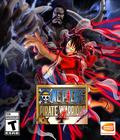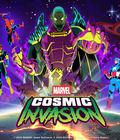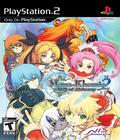Mana Khemia 2: The Fall of Alchemy is a bit unique in that it actually has two separate protagonists, each with his own story and characters. The first is Raze, a servant boy who is dragged by his rich owner to school against his will. While there, he encounters a mysterious man who gifts him with a magical ring that gives him amazing powers. The only problem is that the ring refuses to come off, and Raze notices that his personality is becoming more violent with each passing day. The other character is Ulrika, an unrefined country girl who is in possession of a rare item called a Mana Egg. When the egg hatches, she finds herself caught in the middle of a war between two factions of Mana, and both have taken a great interest in the Mana that emerged from her egg. The two stories run parallel to one another, and the end result is that you'll frequently encounter the characters from the other story over the course of the game. Once you've finished both characters' stories, a new, final chapter is unlocked where both groups team up to battle the final enemy.
Mana Khemia 2's biggest problem is that it is too long. This may be an odd complaint to put forth about an RPG, but Mana Khemia 2 is proof that it can be true. The problem is that Mana Khemia 2 has two character plotlines but barely enough content for one. The end result is that the two stories share a ridiculous amount of the same material. You'll fight the same enemies, visit the same dungeons, do the same quests, and see many of the same events. You basically have to play the entire game a second time, complete with required tutorials, in order to reach the final chapter of the game. There are some divergences but certainly not enough to make playing through the entire game a second time feel like anything more than a chore. Even a single character's path feels fairly empty, and trying to stretch the game's limited material over two paths makes the experience take entirely too long. Add in the fact that the few plot twists in the other chapters are spoiled at the end of one character's playthrough, and the second character's story becomes nothing but an extended trip in rehashing things that you already know.
Mana Khemia is divided into chapters, each of which is divided into weeks, which are taken up by one of two things: assignments or free time. Assignments are required classes that your characters have to take in order to graduate from school. At the beginning of most of the weeks, you're assigned a minimum number of assignments to complete. Some are mandatory classes, while others can be selected from a list, but each class involves your character being given a specific task. You may have to create a certain item using alchemy, defeat a monster under certain conditions, or undertake various other challenges. You're graded on your success for each mission, so if you complete every objective quickly and efficiently, you get an A. Do poorly, and your grades will suffer. Each grade is worth a certain amount of credits, so if you do very well in your classes, you have to take fewer classes than usual during a week, giving you more free time. Do poorly, and you'll have to take additional classes and maybe even attend punishment classes. For the most part, these assignments are easy and usually involve going to a location and performing a very basic task. I didn't encounter class in which it seemed possible to fail until extremely late in the game. Even then, the task was more of a gimmick than an actual challenge. While there is the risk of punishment for doing poorly in your classes, it very likely will never occur.
The reason to do well in your classes is to earn more free time. Any day that's not taken up by assignments is given to your characters as free time, during which a few new features are available to you. You can take jobs, which involve either creating specific items for characters or hunting down enemies in the various dungeons. Completing them successfully can earn you rare items and recipes that can be used to further power up your characters. You can also choose to open up a student store, which lets you sell items that you've created. While this isn't a bad way to earn a bit of extra cash, the real benefit is that the items you sell become available in the game's other stores. This isn't particularly useful for common items, but it makes it a lot easier to keep a supply of the rare items on hand.
Finally, free time can also be spent on character quests, which are special assignments that pertain to one of the characters in your party. Performing these quests gives you a bit of backstory on the character and can occasionally unlock new abilities or items. Completing these quests also allows you to earn a different ending for the game, depending on which character you favored the most. Unfortunately, while the plots involved with the character quests can be fun, the actual quests are incredibly boring. The majority of them involve simply trekking through a dungeon that you've already visited. There's no real thought to them, and many don't even involve interesting battles or challenges. It seems that the only reason to have gameplay at all instead of lengthy cut scenes is to make them last a little longer. If you enjoy the characters, this may not be much of a problem, but those who are looking for interesting gameplay, this makes the overly long chapters drag out even more.
Whether during an assignments or free time, most of your time in the game is going to be spent in the various dungeons that litter the island. These dungeons are home to terrible monsters and rare alchemy ingredients, which is the reason you'll have to venture inside. Most of the dungeons are extremely linear and straightforward, so you'll move from point A to point B, and there's little exploring to be done. There are a few dungeons with gimmicks, such as an underwater dungeon where you can swim around, but these are very few and far between, and they feel disconnected from the story. Like the previous Mana Khemia, monsters wander around as shapeless blobs, colored either red or blue. If you come in contact with a monster, a Quick Time Event button prompt will appear. If you press it correctly, you'll gain an advantage on the enemies, but if you fail, they get to attack first. Blue-colored enemies will be instantly destroyed by a successful button press, allowing you to collect a prize for defeating them without even fighting.
Combat is basically unchanged from Mana Khemia, although there have been a number of gameplay tweaks. The combat is your average RPG-style system, with players and enemies taking turns to beat each other up. Perhaps the most unique feature is the Time Sphere system, which returns from Mana Khemia. Combat is built upon the constantly circling spheres of time, with certain character's actions taking up a certain sphere. The more powerful an attack you use, the longer it will take for your character to get to his next turn sphere. You can use certain moves to do things like place traps in certain spheres or launch attacks that activate on certain spheres. It may sound complex, but it's actually a very easy system to learn.
Your party is made up of up to six characters, three of whom are vanguard characters who stand in the front row and fight your enemy. The other three are support characters who wait on the sidelines. The Vanguard characters fight and, at any time, can call in one of the support characters to replace them. A support character will perform a special move when he is summoned, which can either do extra damage to an enemy or provide a special defense against attacks. Either way, learning to correctly execute a support attack and support defend moves makes combat a lot easier. In addition to this, any character who is not in the vanguard slowly recovers his SP, which is what fuels your special attacks. Careful use of your support switching allows you to use some of your most powerful moves at will.
If you learn to combo your attacks well, you'll fill up your party's Union bar, which, when full, lets your party enter Union mode where all of your attacks are stronger and faster. The most important features of Union mode are the Intimate Attack and Intimate Guard, which are improved versions of Support Attack and Support Defend, respectively, and can only be performed during Union mode. They offer significantly greater attack and defensive abilities but also take up a hefty portion of your Union bar. When the bar is empty, the Union ends until you refill it. Union mode also adds a second bar called the finisher gauge, which fills up as you perform combos in Union mode. When the finisher gauge is full, you'll perform a special finisher move with one of your characters for ridiculous damage.
All in all, Mana Khemia 2's combat is solid, if unexceptional. It hasn't changed very much from the original game, and most of the gameplay tweaks exist to prevent some of the more obvious system abuses that were present in the original title. The Intimate Attack and Guard mechanics lend an interesting element of resource conservation to your abilities, which is rather lacking in the normal combat due to the SP-replenishing ability of the support feature. However, there is very little need to worry about advanced strategy, since the game is extremely easy. You can get by most of the difficult fights by just spamming your strongest attacks and occasionally switching characters. Like many of the Gust titles, Mana Khemia 2 features a wide variety of combat tactics for which there's no use in the game. Even the toughest enemies tend to fall very quickly to your characters, and trying advanced tactics feels rather worthless when you'll win fights too quickly for it to matter. The cast feels so large that it seems as if abilities and gimmicks for some characters overlap a bit much. This isn't as big a problem when the parties are separate, but it stands out once they finally team up.
Outside of combat, the only thing to do in dungeons is to find gathering points, which are locations where rare alchemy materials can be found. You can farm these points once per visit into the dungeon, and in exchange, you'll gain rare items. A nice change from Mana Khemia is that there is more interactivity with these points. With the exception of gathering fruit and collecting water, each gathering has a simple mini-game connected to it. Mining, for example, requires you to memorize a sequence of buttons and then press them in order. The more button presses you get correct, the greater your prize. You can even create special items that make these mini-games easier and improve your ability to gather items. Ultimately, being good at gathering drastically cuts down on the number of visits you'll need to make to the repetitive dungeons. Unfortunately, there's still quite a bit of gathering to be done, and the mini-games can grow a bit tedious after a while, especially when you get the game's advanced equipment and all the mini-games become ridiculously easy and tedious.
Gathering is important for one of Mana Khemia 2's other major features: alchemy. You're at school to learn about alchemy, so you'll have to use alchemy to create basically every item in the game. You find a recipe for an item — either by buying it, finding the recipe in a chest in a dungeon, winning it from a boss fight, or by modifying an existing recipe — and you go to your workshop to create the item by mixing together various ingredients. Some ingredients are required, while others can be substituted to change the overall quality of the items. Finally, you pick one of your party members to assist you. Each party member brings his own special benefits to the table (i.e., the Fire Mana Yun is better at mixing fire-related items). Once you've set it all up, you simply have to play a mini-game order to create your item. Each item has an Ether Level, or E-Level, value from one to 100 that determines the item's quality. The mini-game involves matching the color of a spinning wheel to the element of the ingredient. If you match correctly, the created item's E-Level will increase, but if you match the opposite color, it will decrease. Otherwise, there is no effect. Once you've played this mini-game for each of the ingredients, the item is created. While an E-Level of 100 is considered a perfect item, E-Level 100 doesn't necessarily give you the best possible attributes. Depending on the item, the optimal E-Level may be 20, 80 or even zero.
Creating items is not just important for earning new equipment and making rare healing items, but each item you create also unlocks part of a character's "Grow Book," which is how the characters level up. Each unlocked item unlocks another potential set of upgrades, from improved attack and defense abilities to new attacks and skills. Each item you create unlocks two new upgrades that can then be purchased with AP, which is won from battles. As you upgrade your character, you'll also earn new titles, which grant special passive abilities. Making the strongest character isn't as easy as making an item, though, because every single Grow Book entry also has a hidden third entry, which can only be unlocked if the E-Level of the created item is 100. This is where a rather tedious element of the alchemy system comes into play. It's not difficult to make an E-Level 100 item, but it's annoying to have to create the same item two or three times in order to get good equipment and an E-Level 100 version as well. It doesn't take that long, but with the sheer amount of items in the game, it gets tedious very quickly.
Mana Khemia 2 suffers from many of the same production errors that NISA's Ar Tonelico 2 did, although fortunately the overall quality is a little higher. Translation errors abound in the game, with names and terms being translated in different ways in different places. There are more than a few lines that are either translated incorrectly or written so poorly that it's almost incomprehensible. This is particularly annoying when you're trying to figure out the exact effects of certain items or abilities. Perhaps most frustrating of all is that the exact same game-breaking glitch that was found in Ar Tonelico 2 is present in Mana Khemia 2. One of the optional bosses you can fight during your free time will crash the game when it performs one of its moves, unless you defeat it before it can do so. Since this boss is necessary to fight in order to get some recipes early on, this can be a rather annoying glitch, although careful item usage or grinding allows you to get past it. On top of this, the title hasn't really improved visually over the last game. A number of sprites are reused, most of the areas are bland and boring, with no original artwork or design to be found anywhere, and there are a number of cheap shortcuts used to avoid making new sprites or areas. The overall quality of the game is low, and the entire thing feels half-baked, even before the frustrating translation issues crop up.
Mana Khemia 2: The Fall of Alchemy feels like a half-finished game. The combat and fun, basic design are still there, but there appears to have been no effort expended in making the rest of the game any good. Reused designs and sprites are everywhere, and the combat feels half-done and uninteresting. The two-character story could have been a great way to improve the game's length but ends up just feeling like a way to pad out the gameplay while reusing a vast amount of material. To top it all off, the translation is below average, and since the game is built on such silly characters and unusual items, that hurts it a lot . The end result is a game that looks like the original Mana Khemia but isn't as fun. PS2 gamers who are absolutely dying for a new PS2 RPG will find that Mana Khemia 2 is their only choice, but for those who are willing to play something older, there are certainly better games out there, including the original Mana Khemia.
Score: 5.5/10
More articles about Mana Khemia 2: Fall of Alchemy










 Mana Khemia evolves to a new level with the ultimate 2D graphics blended with anime influenced 3D environments. Game play is as excellent as its looks with plenty of action and tons of item crafting. Players can indulge in the hardcore world of gaming with the highest degree possible on the PS2.
Mana Khemia evolves to a new level with the ultimate 2D graphics blended with anime influenced 3D environments. Game play is as excellent as its looks with plenty of action and tons of item crafting. Players can indulge in the hardcore world of gaming with the highest degree possible on the PS2.



























































